Investigation of the Photon to Charge Conversion and Its Implication on Photovoltaic Cell Efficient Operation
Abstract
1. Introduction
2. Materials and Methods
3. Photovoltaic Cell Energy Conversion
3.1. Fundamental Aspects
3.2. Photogenerated Current
3.3. Recombination Limits
3.3.1. Single Junction Cells
3.3.2. Multi Cells Approaches
3.3.3. Spectrum Oriented Optimization
3.3.4. Design Optimization
3.3.5. Nature-Inspired Solar to Energy Conversion
4. Results and Discussion
4.1. Impacts of Material Properties and Fabrication Processes
4.2. Impact of Energy Harvesting on Energy Conversion Value
4.3. Impacts of Light Harvesting on Photon to Charge Transfer
Energy Transfer Interactions
5. Conclusions
- Key technology determinants on photon to charge efficiency are examined.
- Design, fabrication, and material impacts are presented.
- Efficient thermal energy dissipation and light harvesting improve performance.
- Nature-inspired photosynthetic optimization is discussed.
- Quantum dynamics are emphasized.
Author Contributions
Funding
Conflicts of Interest
References
- Lin, B.; Xu, M. Regional differences on CO2 emission efficiency in metallurgical industry of China. Energy Policy 2018, 120, 302–311. [Google Scholar] [CrossRef]
- Adom, P.K.; Kwakwa, P.A.; Amankwaa, A. The long-run effects of economic, demographic, and political indices on actual and potential CO2 emissions. J. Environ. Manag. 2018, 218, 516–526. [Google Scholar] [CrossRef] [PubMed]
- Dulebenets, M.A. A comprehensive multi-objective optimization model for the vessel scheduling problem in liner shipping. Int. J. Prod. Econ. 2018, 196, 293–318. [Google Scholar] [CrossRef]
- Andersson, F.N.; Opper, S.; Khalid, U. Are capitalists green? Firm ownership and provincial CO2 emissions in China. Energy Policy 2018, 123, 349–359. [Google Scholar] [CrossRef]
- Abioye, O.F.; Dulebenets, M.A.; Pasha, J.; Kavoosi, M. A vessel schedule recovery problem at the liner shipping route with Emission Control Areas. Energies 2019, 12, 2380. [Google Scholar] [CrossRef]
- Lo, P.L.; Martini, G.; Porta, F.; Scotti, D. The determinants of CO2 emissions of air transport passenger traffic: An analysis of Lombardy (Italy). Transp. Policy 2018, 91, 108–119. [Google Scholar] [CrossRef]
- Wiginton, L.K. Quantifying rooftop solar photovoltaic potential for regional renewable energy policy. Comput. Environ. Urban. Syst. 2010, 34, 345–357. [Google Scholar] [CrossRef]
- Ko, L. Evaluation of the development potential of rooftop solar photovoltaic in Taiwan. Renew. Energy 2015, 76, 582–595. [Google Scholar] [CrossRef]
- Santos, I.P.; Ruther, R. The potential of building-integrated (BIPV) and building-applied photovoltaics (BAPV) in single-family, urban residences at low latitudes in Brazil. Energy Build. 2012, 50, 290–297. [Google Scholar] [CrossRef]
- Zhao, X.; Zhang, X.; Riffat, S.B.; Su, Y. Theoretical study of the performance of a novel PV/e roof module for heat pump operation. Energy Convers. Manag. 2011, 52, 603–614. [Google Scholar] [CrossRef]
- Ramos, A.; Chatzopoulou, M.A.; Guarracino, I.; Freeman, J.; Markides, C.N. Hybrid photovoltaic-thermal solar systems for combined heating, cooling and power provision in the urban environment. Energy Convers. Manag. 2017, 150, 838–850. [Google Scholar] [CrossRef]
- Aravossis, K.G.; Kapsalis, V.C. Power Engineering: Advances and Challenges Part A. In Thermal Energy Storage Technologies; CRC Press: Boca Raton, FL, USA; Taylor and Francis Group: Abingdon, UK, 2018; Chapter 13; pp. 83–420. [Google Scholar]
- Qazi, S. Fixed Standalone PV Systems for Disaster Relief and Remote Areas. Chapter 5, In: Standalone Photovoltaic (PV) Systems for Disaster Relief and Remote Areas; Elsevier: Amsterdam, The Netherlands, 2017; Chapter 5; pp. 139–175. [Google Scholar] [CrossRef]
- Murty, A.S.R.; Rajanish, Y.P.D. Enhanced energy harvesting and analysis of a high concentration photovoltaic / thermal system with support of cooling fluid and increased mass flow rates. Int. J. Eng. Technol. 2016, 8, 1077–1085. [Google Scholar]
- Maranda, W. Analysis of self-consumption of energy from grid-connected photovoltaic system for various load scenarios with short-term buffering. SN Appl. Sci. 2019, 1, 406. [Google Scholar] [CrossRef]
- Parida, A.; Choudhury, S.; Chatterjee, D. Optimized Solar PV Based Distributed Generation System Suitable for Cost-Effective Energy Supply. In Proceedings of the 9th Power India International Conference, Delhi, India, 28 February–1 March 2020; pp. 1–6. [Google Scholar] [CrossRef]
- Ban-Weiss, G.; Wray, C.; Woody, W.; Ly, P.; Akbari, H.; Levinson, R. Electricity production and cooling energy savings from installation of a building-integrated photovoltaic roof on an office building. Energy Build. 2013, 56, 210–220. [Google Scholar] [CrossRef]
- Dale, M.; Benson, S.M. Energy Balance of the Global Photovoltaic (PV) Industry–Is the PV Industry a Net Electricity Producer? Environ. Sci. Technol. 2013, 47, 3482–3489. [Google Scholar] [CrossRef] [PubMed]
- Koo, C.; Hong, T.; Park, H.S.; Yun, G. Framework for the analysis of the potential of the rooftop photovoltaic system to achieve the net-zero energy solar buildings. Prog. Photovolt. Res. Appl. 2014, 22, 462–478. [Google Scholar] [CrossRef]
- Ciulla, G.; Brano, V.L.; Di Dio, V.; Cipriani, G. A comparison of different one-diode models for the representation of I–V characteristic of a PV cell. Renew. Sustain. Energy Rev. 2014, 32, 684–696. [Google Scholar] [CrossRef]
- Kilkis, S. A Rational Exergy Management Model for Curbing Building CO2 Emissions (LB-07-013), American Society of Heating, Refrigerating and Air-Conditioning Engineers (ASHRAE). Transactions 2007, 113, 76–86. [Google Scholar]
- Onu, P.; Mbohwa, C. Advances in Solar Photovoltaic Grid Parity. In Proceedings of the 7th International Renewable and Sustainable Energy Conference (IRSEC), Agadir, Morocco, 27–30 November 2019; pp. 1–6. [Google Scholar] [CrossRef]
- Drabiniok, E.; Neyer, A. Bionic micro porous evaporation foil for photovoltaic cell cooling. Microelectron. Eng. 2014, 119, 65–69. [Google Scholar] [CrossRef]
- Ciulla, G.; Brano, V.L.; Cellura, M.; Franzotta, V.; Milone, D. A Finite Difference Model of a PV-PCM System. Energy Procedia 2012, 30, 198–206. [Google Scholar] [CrossRef]
- Kichou, S.; Skandalos, N.; Wolf, P. Energy performance enhancement of a researchcentre based on solar potential analysis and energy management. Energy 2019, 183, 1195–1210. [Google Scholar] [CrossRef]
- Park, J.; Kim, T.; Leigh, S.-B. Application of a phase-change material to improve the electrical performance of vertical-building-added photovoltaics considering the annual weather conditions. Solar Energy 2014, 105, 561–574. [Google Scholar] [CrossRef]
- Browne, M.C.; Norton, B.; McCormack, S.J. Phase change materials for photovoltaic thermal management. Renew. Sustain. Energy Rev. 2015, 47, 762–782. [Google Scholar] [CrossRef]
- Hasan, A.; McCormack, S.J.; Huang, M.J.; Norton, B. Characterization of phase change materials for thermal control of photovoltaics using Differential Scanning Calorimetry and Temperature History Method. Energy Convers. Manag. 2014, 81, 322–329. [Google Scholar] [CrossRef]
- Atkin, P.; Farid, M.M. Improving the efficiency of photovoltaic cells using PCM infused graphite and aluminum fins. Solar Energy 2015, 114, 217–228. [Google Scholar] [CrossRef]
- Chandrasekar, M.; Rajkumar, S.; Valavan, D. A review on the thermal regulation techniques for nonintegrated flat PV modules mounted on building top. Energy Build. 2015, 86, 692–697. [Google Scholar] [CrossRef]
- Hasanuzzaman, M.; Malek, A.B.M.A.; Islam, M.M.; Pandey, A.K.; Rahim, N.A. Global advancement of cooling technologies for PV systems: A review. Solar Energy 2016, 137, 25–45. [Google Scholar] [CrossRef]
- Cui, Y.; Wang, Y.; Huang, Q.; Wei, S. Effect of radiation and convection heat transfer on cooling performance of radiative panel. Renew. Energy 2016, 99, 10–17. [Google Scholar] [CrossRef]
- Kandeal, A.W.; Thakur, A.M.; Elkadeem, M.R.; Elmorshedy, M.F.; Ullah, Z.; Sathyamurthy, R.; Sharshir, S.W. Photovoltaics performance improvement using different cooling methodologies: A State-of-Art Review. J. Clean. Prod. 2020, 273, 122772. [Google Scholar] [CrossRef]
- Hrica, J.; Chatterjee, S.; TamizhMani, G. BAPV array: Thermal modeling and cooling effect of exhaust fan. In Proceedings of the 37th IEEE Photovoltaic Specialists Conference, Seattle, DC, USA, 19–24 June 2011; pp. 3144–3149. [Google Scholar] [CrossRef]
- Kapsalis, V.C.; Karamanis, D. On the effect of roof added photovoltaics on building’s energy performance. Energy Build. 2015, 108, 195–204. [Google Scholar] [CrossRef]
- Kichou, S.; Silvestre, S.; Guglielminotti, L.; Mora-López, L.; Muñoz-Cerón, E. Comparison of two PV array models for the simulation of PV systems using five different algorithms for the parameters identification. Renew. Energy 2016, 99, 270–279. [Google Scholar] [CrossRef]
- Kim, G.G.; Choi, J.H.; Park, S.Y.; Bhang, B.G.; Nam, W.J.; Cha, H.L.; Park, N.; Ahn, H.-K. Prediction Model for PV Performance With Correlation Analysis of Environmental Variables. IEEE J. Photovolt. 2019, 9, 832–841. [Google Scholar] [CrossRef]
- Kichou, S.; Silvestre, S.; Nofuentes, G.; Torres-Ramírez, M.; Chouder, A.; Guasch, D. Characterization of degradation and evaluation of model parameters of amorphous silicon photovoltaic modules under outdoor long-term exposure. Energy 2016, 96, 231–241. [Google Scholar] [CrossRef]
- Shen, L.; Li, Z.; Ma, T. Analysis of the power loss and quantification of the energy distribution in PV module. Appl. Energy 2020, 260, 114333. [Google Scholar] [CrossRef]
- Stradins, P. Staebler-Wronski defects: Creation efficiency, stability, and effect on a-Si:H solar cell degradation. In Proceedings of the 35th IEEE Photovoltaic Specialists Conference, Honolulu, HI, USA, 20–25 June 2010; pp. 142–145. [Google Scholar] [CrossRef]
- Shockley, W.; Queisser, H. Detailed Balance Limit of Efficiency of p-n Junction Solar Cells. J. Appl. Phys. 1961, 32, 510–519. [Google Scholar] [CrossRef]
- Luque, A. Will we exceed 50% efficiency in photovoltaics. J. Appl. Phys. 2011, 110, 031301. [Google Scholar] [CrossRef]
- Kerr, J.M.; Cuevas, A. General parameterization of Auger recombination in crystalline silicon. J. Appl. Phys. 2002, 91, 2473. [Google Scholar] [CrossRef]
- Augusto, A.; Herasimenk, Y.S.; King, R.R.; Bowden, G.S.; Honsberg, C. Analysis of the recombination mechanisms of a silicon solar cell with low bandgap-voltage offset. J. Appl. Phys. 2017, 121, 205704. [Google Scholar] [CrossRef]
- Hsieh, M.; Kaiser, A.; Bhattacharya, S.; Sajeev, J.; Lin, S.-Y. Experimental demonstration of broadband solar absorption beyond the lambertian limit in certain thin silicon photonic crystals. Sci. Rep. 2020, 10, 11857. [Google Scholar] [CrossRef] [PubMed]
- Bhattacharya, S.; Sajeev, J. Photonic crystal light trapping: Beyond 30% conversion efficiency for silicon photovoltaic. APL Photon. 2020, 5, 20902. [Google Scholar] [CrossRef]
- Carle, J.E.; Krebs, F.C. Technological status of organic photovoltaics (opv). Sol. Energy Mater. Solar Cells 2013, 119, 309–310. [Google Scholar] [CrossRef]
- Service, R.F. Outlook brightness for plastic solar cells. Science 2011, 293. [Google Scholar] [CrossRef]
- Kamat, P.V. Quantum dot solar cells. Semiconductor nanocrystals as light harvesters. J. Phys. Chem. C 2008, 112, 18737–18753. [Google Scholar] [CrossRef]
- Skandalos, N.; Karamanis, D. PV glazing technologies. Renew. Sustain. Energy Rev. 2015, 49, 306–322. [Google Scholar] [CrossRef]
- McGehee, M.D. Materials Science: Fast—Truck solar cells. Nature 2013, 501, 323–325. [Google Scholar] [CrossRef]
- Snaith, H.J. Perovskites: A emergence of new era for low cost, high efficiency solar cells. Phys. Chem. Lett. 2013, 4, 3623–3630. [Google Scholar] [CrossRef]
- Bozyigit, D.; Volk, S.; Yarema, O.; Wood, V. Quantification of deep traps in nanocrystal solids, their electronic properties and the influence on device behavior. Nano Lett. 2013, 13, 5284–5288. [Google Scholar] [CrossRef] [PubMed]
- Chuang, C.H.M.; Brown, P.R.; Bulovic, V.; Bawendi, M.G. Improved performance and stability in quantum dot solar cells through band alignment engineering. Nat. Mat. 2014, 13, 796–801. [Google Scholar] [CrossRef]
- Wang, W.; Lin, A.S.; Phillips, J.D. Intermediate-band photovoltaic solar cell based on ZnTe: O. Appl. Phys. Lett. 2009, 95, 11103. [Google Scholar] [CrossRef]
- Marti, A.; Tablero, C.; Antolin, E.; Luque, A.; Campion, R.; Novikov, S.; Foxon, C.T. Potential of mn doped ln1−xgaxn for implementing intermediate band solar cells. Sol. Energy Mater. Solar Cells 2009, 93, 641–644. [Google Scholar] [CrossRef]
- Luque, A.; Marti, A.; Lopez, N.; Antolin, E.; Canovas, E.; Stanley, C.; Farmer, C.; Caballero, L.J.; Cuadra, L.; Balenzategui, J.L. Experimental analysis of the quasi-Fermi level split in quantum dot intermediate-band solar cells. Appl. Phys. Lett. 2005, 87, 83505. [Google Scholar] [CrossRef]
- Shao, Q.; Balandin, A.; Fedoseyev, A.; Turowski, M. Intermediate-band solar cells based on quantum dot supracrystals. Appl. Phys. Lett. 2007, 91, 163503. [Google Scholar] [CrossRef]
- Imenes, A.G.; Mills, D.R. Spectral beam splitting technology for increased conversion efficiency in solar concentrating systems: A review. Solar Energy Mater. Solar Cells 2004, 84, 19–69. [Google Scholar] [CrossRef]
- Hossain, M.I.; Bousselham, A.; Alharbi, F.H. Optical concentration effects on conversion efficiency of a split-spectrum solar cell system. J. Phys. D Appl. Phys. 2014, 47, 075101. [Google Scholar] [CrossRef]
- Abrams, Z.R.; Gharghi, M.; Niv, A.; Gladden, C.; Zhang, X. Theoretical efficiency of 3rd generation solar cells: Comparison between carrier multiplication and down-conversion. Sol. Energy Mater. Sol. Cells 2012, 99, 308–315. [Google Scholar] [CrossRef]
- Bett, A.W.; Dimroth, F.; Stollwerck, G.; Sulima, O.V. III-V compounds for solar cell applications. Appl. Phys. A 1999, 69, 119–129. [Google Scholar] [CrossRef]
- Meckler, M. Fixed Solar Concentrator-Collector-Satellite Receiver and Co-Generator. U.S. Patent 4 490-981, 1 January 1985. [Google Scholar]
- Erim, M.N.; Erim, N.; Kurt, H. Spectral splitting for an InGaP/GaAs parallel junction solar cell. Appl. Opt. 2019, 58, 4265–4270. [Google Scholar] [CrossRef] [PubMed]
- Wei, A.C.; Chang, W.J.; Sze, J.R. A Side-Absorption Concentrated Module with a Diffractive Optical Element as a Spectral-Beam-Splitter for a Hybrid-Collecting Solar System. Energies 2020, 13, 192. [Google Scholar] [CrossRef]
- Shaller, R.D.; Klimov, V.I. High efficiency carrier multiplication in PbSe nanocrystals: Implications for solar energy conversion. Phys. Rev. Lett. 2004, 92, 186601–186604. [Google Scholar] [CrossRef]
- Takeda, Y.; Motohiro, T. Requisites to realize high conversion efficiency of solar cells utilizing carrier multiplication. Sol. Energy Mater. Sol. Cells 2010, 94, 1399–1405. [Google Scholar] [CrossRef]
- Green, M.A. Third generation photovoltaics: Solar cells for 2020 and beyond. Phys. E Low Dimens. Syst. Nanostruct. 2002, 14, 65–70. [Google Scholar] [CrossRef]
- Conibeer, G.; König, D.; Green, M.; Guillemoles, J. Slowing of carrier cooling in hot carrier solar cells. Thin Solid Film. 2008, 516, 6948–6953. [Google Scholar] [CrossRef]
- Sun, D.; Aivazian, G.; Jones, A.M.; Ross, J.S.; Yao, W.; Cobden, D. Ultrafast hot-carrier-dominated photocurrent in graphene. Nat. Nanotechnol. 2012, 7, 114–118. [Google Scholar] [CrossRef] [PubMed]
- Gabor, N.M.; Song, J.C.; Ma, Q.; Nair, N.L.; Taychatanapat, T.; Watanabe, K.; Taniguchi, T.; Levitov, L.S.; Jarillo-Herrero, P. Hot carrier-assisted intrinsic photoresponse in grapheme. Science 2011, 334, 648–652. [Google Scholar] [CrossRef] [PubMed]
- Holliman, J.P.; Mohsen, M.; Connell, A.; Kershaw, P.C.; Meza-Rojas, D.; Jones, W.E.; Geatches, D.; Sen, K.; Hsiao, Y.W. Double Linker Triphenylamine Dyes for Dye-Sensitized Solar Cells. Energies 2020, 13, 4637. [Google Scholar] [CrossRef]
- Utlu, Z. Thermophotovoltaic applications in waste heat recovery systems: Example of GaSb cell. Int. J. Low Carbon Technol. 2020, 15, 277–286. [Google Scholar] [CrossRef]
- Pidgeon, C.R.; Ciesle, C.M.; Murdin, B.N. Suppression of non-radiativeprocesses in semiconductor mid infrared emitters and detectors. Prog. Quantum Electron. 1997, 21, 361–419. [Google Scholar] [CrossRef]
- Ang, Y.S.; Yang, H.Y.; Ang, L.K. Universal scaling laws in Schottky heterostructures based on two dimensional materials. Phys. Rev. Lett. 2018, 121, 56802. [Google Scholar] [CrossRef]
- Xiao, G.; Zheng, G.; Qiu, M.; Li, Q.; Li, D.; Ni, M. Thermionic energy conversion for concentrating solar power. Appl. Energy 2017, 208, 1318–1342. [Google Scholar] [CrossRef]
- Liao, T. Improved design of a photon enhanced thermionic energy converter. IEEE Electron. Device Lett. 2019, 40, 115–118. [Google Scholar] [CrossRef]
- Santhanam, P.; Fan, S. Thermal-to-electric energy conversion by diodes under negative illumination. Phys. Rev. B 2016, 93, 161410. [Google Scholar] [CrossRef]
- Ono, M.; Santhanam, P.; Li, W.; Zhao, B.; Fan, S. Experimental demonstration of energy harvesting from sky using the negative illumination effect of a semiconductor photodiode. Appl. Phys. Lett. 2014, 114, 161102. [Google Scholar] [CrossRef]
- Salem, M.S.; Alzahrani, A.J.; Ramadan, R.A.; Alanazi, A.; Shaker, A.; Abouelatta, M.; Gontrand, C.; Elbanna, M.; Zekry, A. Physically Based Analytical Model of Heavily Doped Silicon Wafers Based Proposed Solar Cell Microstructure. IEEE Access 2020, 8, 138898–138906. [Google Scholar] [CrossRef]
- Ross, R.T.; Hsiao, T.L. Limits on the yield of photochemical solar energy conversion. J. Appl. Phys. 1977, 48, 4783–4785. [Google Scholar] [CrossRef]
- Bolton, R.; Hall, D.O. Photochemical conversion and storage of solar energy. Annu. Rev. Energy 1979, 4, 353–401. [Google Scholar] [CrossRef]
- Engel, G.S.; Calhoun, T.R.; Read, E.L.; Ahn, T.K.; ManCal, T.; Cheng, Y.C.; Blankenship, R.E.; Fleming, G.R. Evidence for wavelike energy transfer through quantum coherence in photosynthetic systems. Nature 2007, 446, 782–786. [Google Scholar] [CrossRef]
- Scholes, G.D. Quantum-coherent electronic energy transfer: Did nature think of it first? J. Phys. Chem. Lett. 2010, 1, 2–8. [Google Scholar] [CrossRef]
- Vlaming, S.M.; Silbey, R.J. Correlated intermolecular coupling fluctuations in photosynthetic complexes. J. Chem. Phys. 2012, 136, 055102. [Google Scholar] [CrossRef] [PubMed]
- Mohseni, M.; Shabani, A.; Lloyd, S.; Rabitz, H. Energy-scales convergence for optimal and robust quantum transport in photosynthetic complexes. J. Chem. Phys. 2014, 140, 035102. [Google Scholar] [CrossRef] [PubMed]
- Creatore, C.; Parker, M.; Emmott, S.; Chin, A. Efficient biologically inspired photocell enhanced by delocalized quantum states. Phys. Rev. Lett. 2013, 111, 253601. [Google Scholar] [CrossRef] [PubMed]
- Heo, J.H.; Im, S.H.; Noh, J.H.; Mandal, T.N.; Lim, C.S.; Chang, J.A.; Lee, Y.H.; Kim, H.; Sarkar, A.; Nazeeruddin, M.K.; et al. Efficient inorganic–organic hybrid heterojunction solar cells containing perovskite compound and polymeric hole conductors. Nat. Photonics 2013, 7, 486–491. [Google Scholar] [CrossRef]
- Jeon, N.J.; Lee, J.; Noh, J.H.; Nazeeruddin, M.K.; Gratzel, M.; Seok, S.I. Efficient inorganic–organic hybrid perovskite solar cells based on pyrene arylamine derivatives as hole-transporting materials. J. Am. Chem. Soc. 2013, 135, 19087–19090. [Google Scholar] [CrossRef]
- Li, G.; Govind, N.; Ratner, A.M.; Cramer, J.C.; Gagliardi, L. Influence of Coherent Tunneling and Incoherent Hopping on the Charge Transfer Mechanism in Linear Donor–ridge–Acceptor Systems. J. Phys. Chem. Lett. 2015, 6, 4889–4897. [Google Scholar] [CrossRef] [PubMed]
- Bastola, E.; Alfadhili, F.K.; Phillips, A.B.; Heben, M.J.; Ellingson, R.J. Wet chemical etching of cadmium telluride photovoltaics for enhanced open-circuit voltage, fill factor, and power conversion efficiency. J. Mater. Res. 2019, 34, 3988–3997. [Google Scholar] [CrossRef]
- Munshi, A.H.; Kephart, J.; Abbas, A.; Raguse, J.; Beaudry, J.N.; Barth, K.; Sites, J.; Walls, J.; Sampath, W. Polycrystalline CdSeTe/CdTe absorber cells with 28 mA/cm2 short-circuit current. IEEE J. Photovolt. 2018, 8, 310. [Google Scholar] [CrossRef]
- Paudel, N.R.; Yan, Y. Enhancing the photo-currents of CdTe thin-film solar cells in both short and long wavelength regions. Appl. Phys. Lett. 2014, 105, 183510. [Google Scholar] [CrossRef]
- Li, J.; Diercks, D.R.; Ohno, T.R.; Warren, C.W.; Lonergan, M.C.; Beach, J.D.; Wolden, C.A. Controlled activation of ZnTe:Cu contacted CdTe solar cells using rapid thermal processing. Sol. Energy Mater. Sol. Cells 2015, 133, 208. [Google Scholar] [CrossRef]
- Bastola, E.; Bhandari, K.P.; Subedi, I.; Podraza, N.J.; Ellingson, R.J. Structural, optical, and hole transport properties of earth-abundant chalcopyrite (CuFeS2) nanocrystals. MRS Commun. 2018, 8, 970. [Google Scholar] [CrossRef]
- Subedi, K.K.; Bastola, E.; Subedi, I.; Song, Z.; Bhandari, K.P.; Phillips, A.B.; Podraza, N.J.; Heben, M.J.; Ellingson, R.J. Nanocomposite (CuS)x(ZnS)1x thin film back contact for CdTe solar cells: Toward a bifacial device. Sol. Energy Mater. Sol. Cells 2018, 186, 227. [Google Scholar] [CrossRef]
- Ochoa-Landin, R.; Vigil-Galan, O.; Vorobiev, Y.V.; Ramírez-Bon, R. Chemically-deposited Te layers improving the parameters of back contacts for CdTe solar cells. Sol. Energy 2009, 83, 134. [Google Scholar] [CrossRef]
- Song, T.; Moore, A.; Sites, J.R. Te Layer to Reduce the CdTe Back-Contact Barrier. IEEE J. Photovolt. 2018, 8, 293–298. [Google Scholar] [CrossRef]
- Watthage, S.C.; Phillips, A.B.; Liyanage, G.K.; Song, Z.; Gibbs, J.M.; Alfadhili, F.K.; Alkhayat, R.B.; Ahangharnejhad, R.H.; Almutawah, Z.S.; Bhandari, K.P. Selective Cd removal from CdTe for high-efficiency Te back-contact formation. IEEE J. Photovolt. 2018, 8, 1125. [Google Scholar] [CrossRef]
- Li, M.; Chang, F.; Li, C.; Xia, C.; Wang, T.; Wang, J.; Sun, M. CIS and CIGS thin films prepared by magnetron sputtering. Procedia Eng. 2012, 27, 12–19. [Google Scholar] [CrossRef][Green Version]
- Gulkowski, S.; Krawczak, E. RF/DC Magnetron Sputtering Deposition of Thin Layers for Solar Cell Fabrication. Coatings 2020, 10, 791. [Google Scholar] [CrossRef]
- Wang, M.; Hossain, M.; Choy, K. Effect of Sodium Treatment on the Performance of Electrostatic Spray Assisted Vapour Deposited Copper-poor Cu(In,Ga)(S,Se) 2 solar cells. Sci. Rep. 2017, 7, 1–10. [Google Scholar] [CrossRef] [PubMed]
- Wagner, J.; Gruber, M.; Hinderhofer, A.; Wilke, A.; Bröker, B.; Frisch, J.; Amsalem, P.; Vollmer, A.; Opitz, A.; Koch, N.; et al. High fill factor and open circuit voltage in organic photovoltaic cells with diindenoperylene as donor material. Adv. Funct. Mater. 2010, 20, 4295–4303. [Google Scholar] [CrossRef]
- Du, J.; Fortney, A.; Washington, E.K.; Biewer, M.C.; Kowalewski, T.; Stefan, M.C. Benzo[1,2-b:4,5-b0]difuran and furan substituted diketopyrrolopyrrole alternating copolymer for organic photovoltaics with high fill factor. J. Mater. Chem. A 2017, 5, 15591. [Google Scholar] [CrossRef]
- Galagan, Y.; Fledderus, H.; Gorter, H.; Mannetje, H.H.; Shanmugam, S.; Mandamparambil, R.; Bosman, J.; Rubingh, J.M.; Teunissen, J.P.; Salem, A.; et al. Roll-to-Roll Slot–Die Coated Organic Photovoltaic (OPV) Modules with High Geometrical Fill Factors. Energy Technol. 2015, 3, 834–842. [Google Scholar] [CrossRef]
- Wang, Z.; Hong, Z.; Zhuang, T.; Chen, G.; Sasabe, H.; Yokoyama, D.; Kido, J. High fill factor and thermal stability of bilayer organic photovoltaic cells with an inverted structure. Appl. Phys. Lett. 2015, 106, 53305. [Google Scholar] [CrossRef]
- Lubieniecki, M.; Uhl, T. Integration of Thermal Energy Harvesting in Semi-Active Piezoelectric Shunt-Damping Systems. J. Electron. Mater. 2015, 44, 341–347. [Google Scholar] [CrossRef]
- Wang, Q.; Bowen, C.R.; Lei, W.; Zhang, H.; Xie, B.; Qiu, S.; Li, M.Y.; Jiang, S. Improved heat transfer for pyroelectric energy harvesting applications using a thermal conductive network of aluminum nitride in PMN-PMS-PZT ceramics. J. Mater. Chem. A 2018, 6, 5040–5051. [Google Scholar] [CrossRef]
- Jeyashree, Y.; Sukhi, Y.; Vimala, J.A.; Lourdu, J.S.; Indirani, S. Concentrated solar thermal energy harvesting using Bi2Te3based thermoelectric generator. Mater. Sci. Semicond. Process. 2020, 107, 104782. [Google Scholar] [CrossRef]
- Ghomian, T.; Kizilkaya, O.; Choi, J.W. Lead sulfide colloidal quantum dot photovoltaic cell for energy harvesting from human body thermal radiation. Appl. Energy 2018, 230, 761–768. [Google Scholar] [CrossRef]
- Chun, J.; Song, H.; Kang, M.; Kang, H.; Kishore, R.A.; Priya, S. Thermo-Magneto-Electric Generator Arrays for Active Heat Recovery System. Sci. Rep. 2017, 7, 41383. [Google Scholar] [CrossRef]
- Scully, M.O. Quantum photocell: Using quantum coherence to reduce radiative recombination and increase efficiency. Phys. Rev. Lett. 2010, 104, 207701. [Google Scholar] [CrossRef]
- Dorfman, K.E.; Voronine, D.V.; Mukamel, S.; Scully, M.O. Photosynthetic reaction center as a quantum heat engine. Proc. Natl. Acad. Sci. USA 2010, 110, 2746–2751. [Google Scholar] [CrossRef]
- Wang, Y.C.; Chen, C.W.; Su, T.Y.; Yang, T.Y.; Liu, W.W.; Cheng, F.; Wang, M.Z.; Chueh, Y.L. Design of suppressing optical and recombination losses in ultrathin CuInGaSe2 solar cells by Voronoi nanocavity arrays. Nano Energy 2020, 78, 2211–2855. [Google Scholar] [CrossRef]
- Boer, K.W.; Pohl, U.W. Photon–Phonon Interaction. In Semiconductor Physics; Springer: Cham, Switzerland, 2018; pp. 389–424. [Google Scholar]
- Kirk, A.P. Advancing solar cell to the limit of energy cascading. In Proceedings of the 39th Photovoltaic Specialists Conference, Tampra Bay, FL, USA, 16–21 June 2013; pp. 782–787. [Google Scholar]
- Schafer, C.; Ruggenthaller, M.; Appel, H.; Rubio, A. Modification of excitation and charge transfer in cavity quantum—Electrodynamical chemistry. Proc. Natl. Acad. Sci. USA 2019, 116, 4883–4892. [Google Scholar] [CrossRef]
- Panhans, M.; Hutsch, S.; Benduhn, J.; Schellhammer, K.S.; Nikolis, V.C.; Vangerven, T.; Vandewal, K.; Ortmann, F. Molecular vibrations reduce the maximum achievable photovoltage in organic solar cells. Nat. Commun. 2020, 11, 1488. [Google Scholar] [CrossRef]
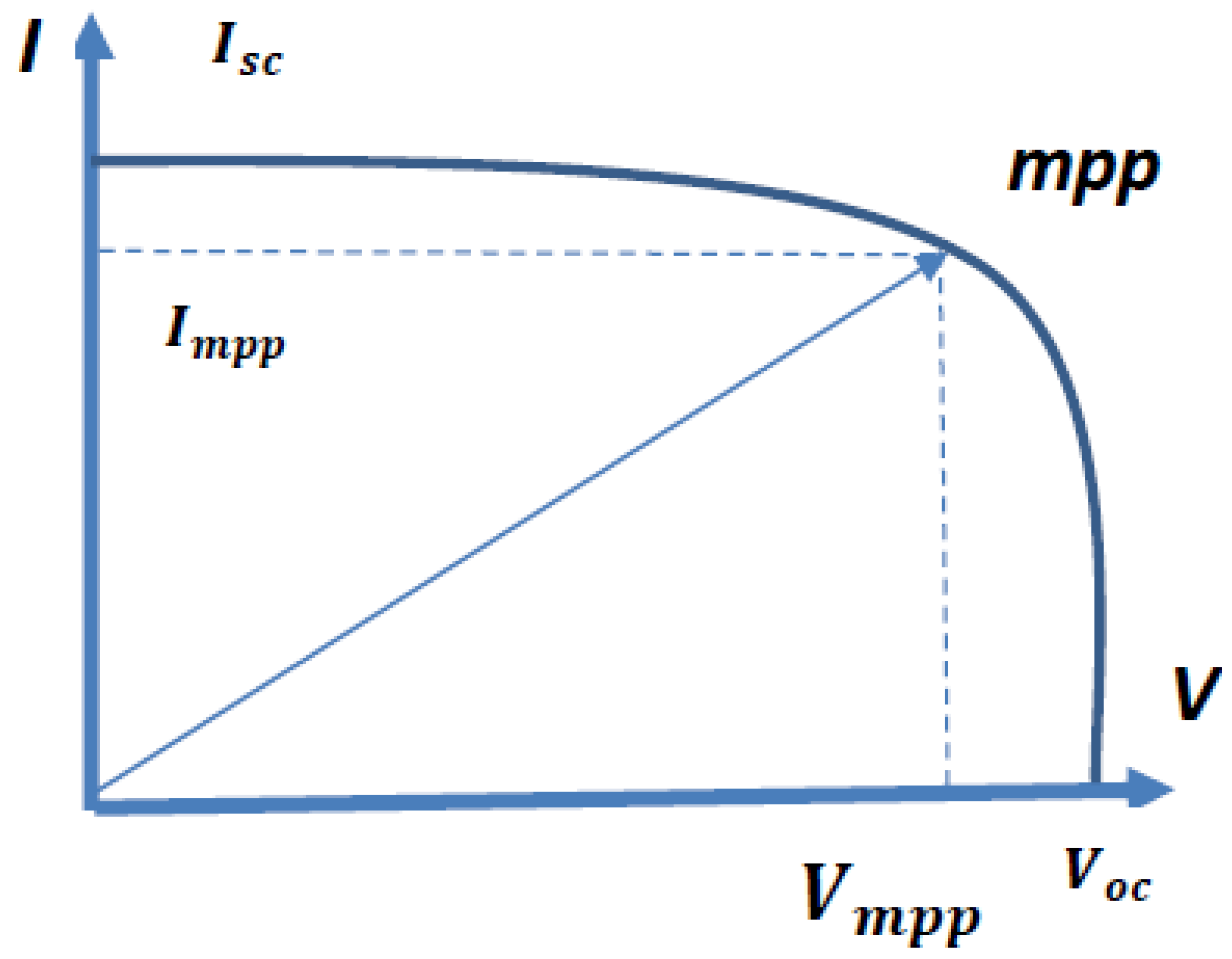
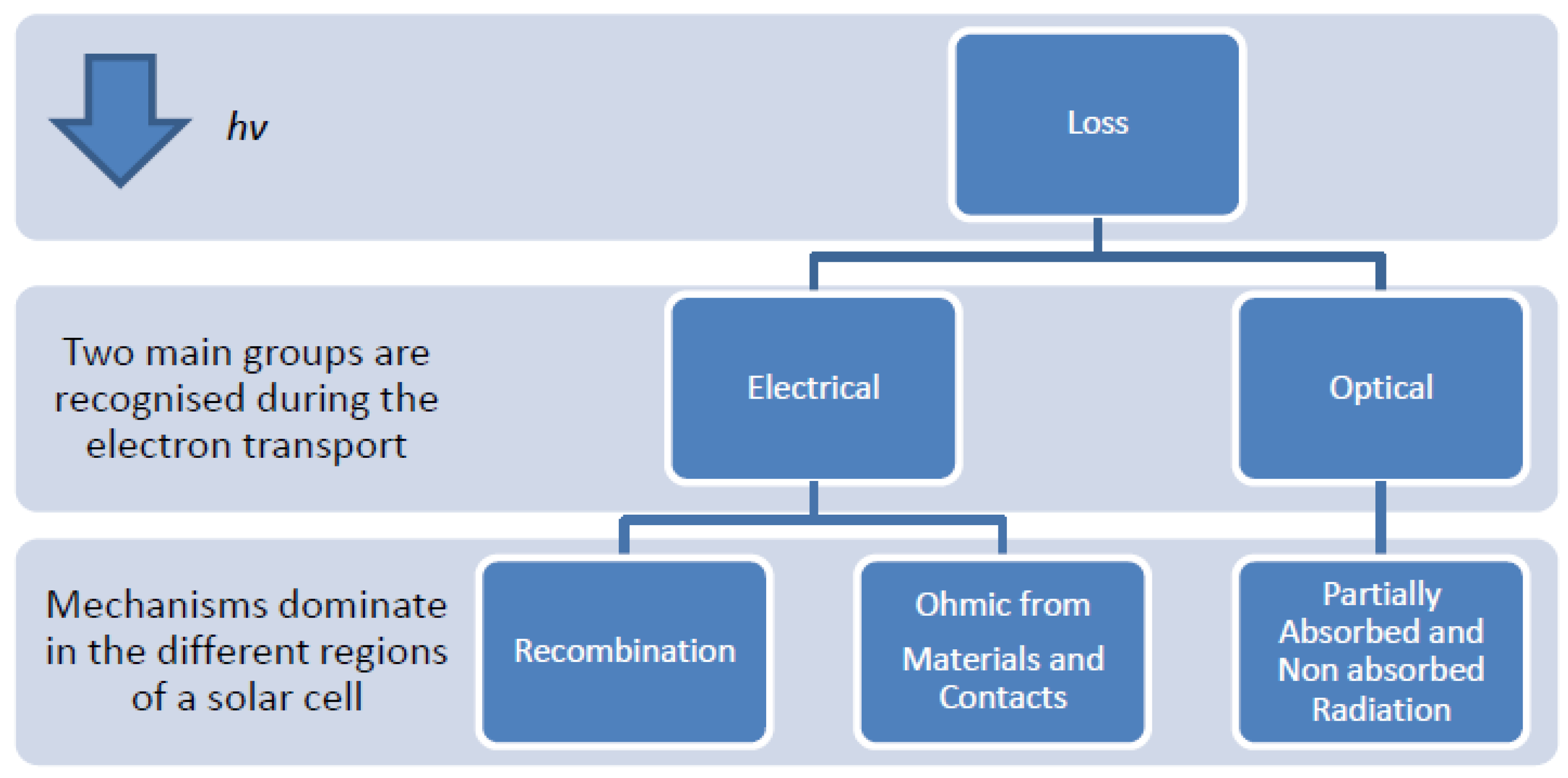
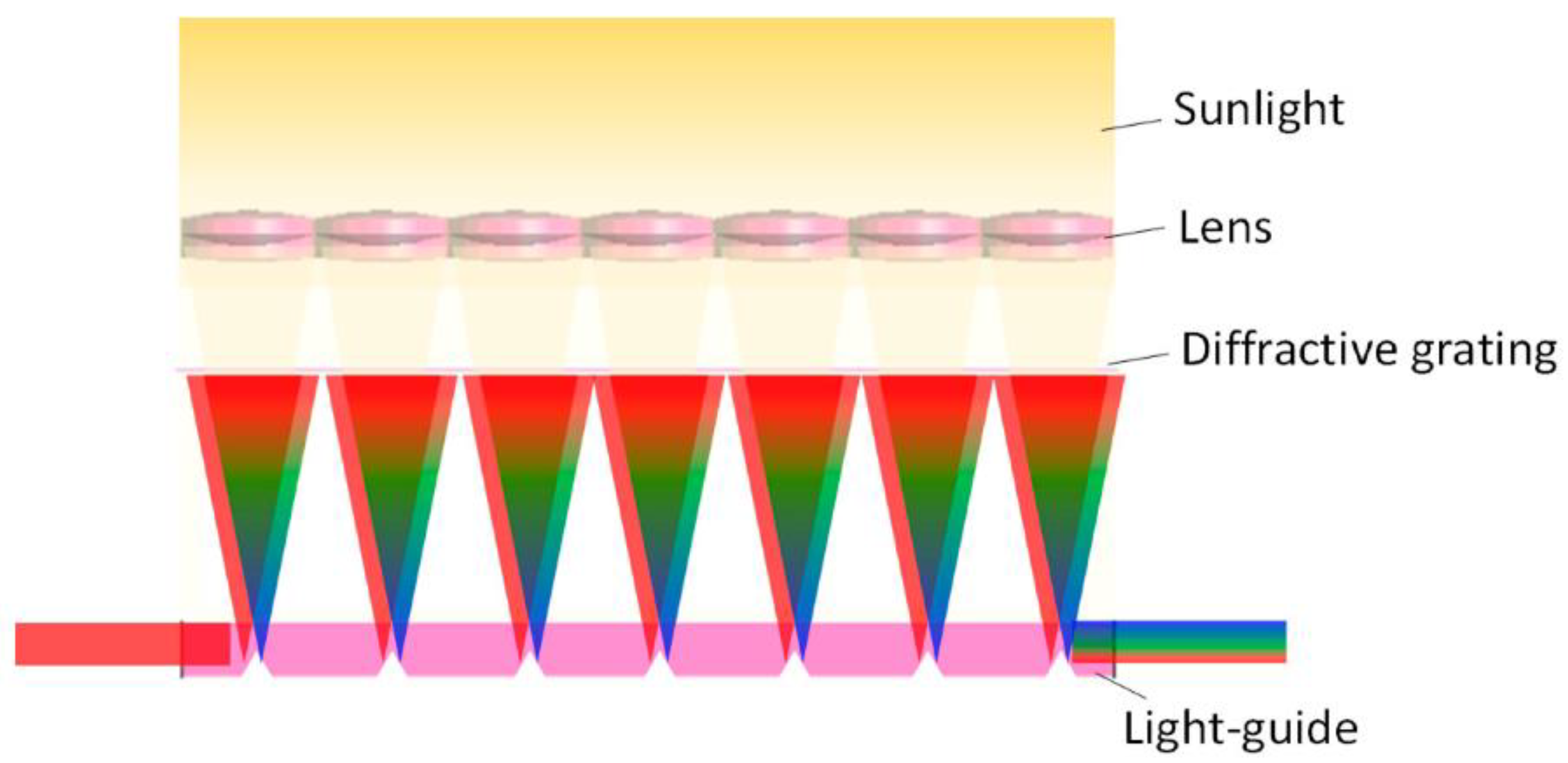
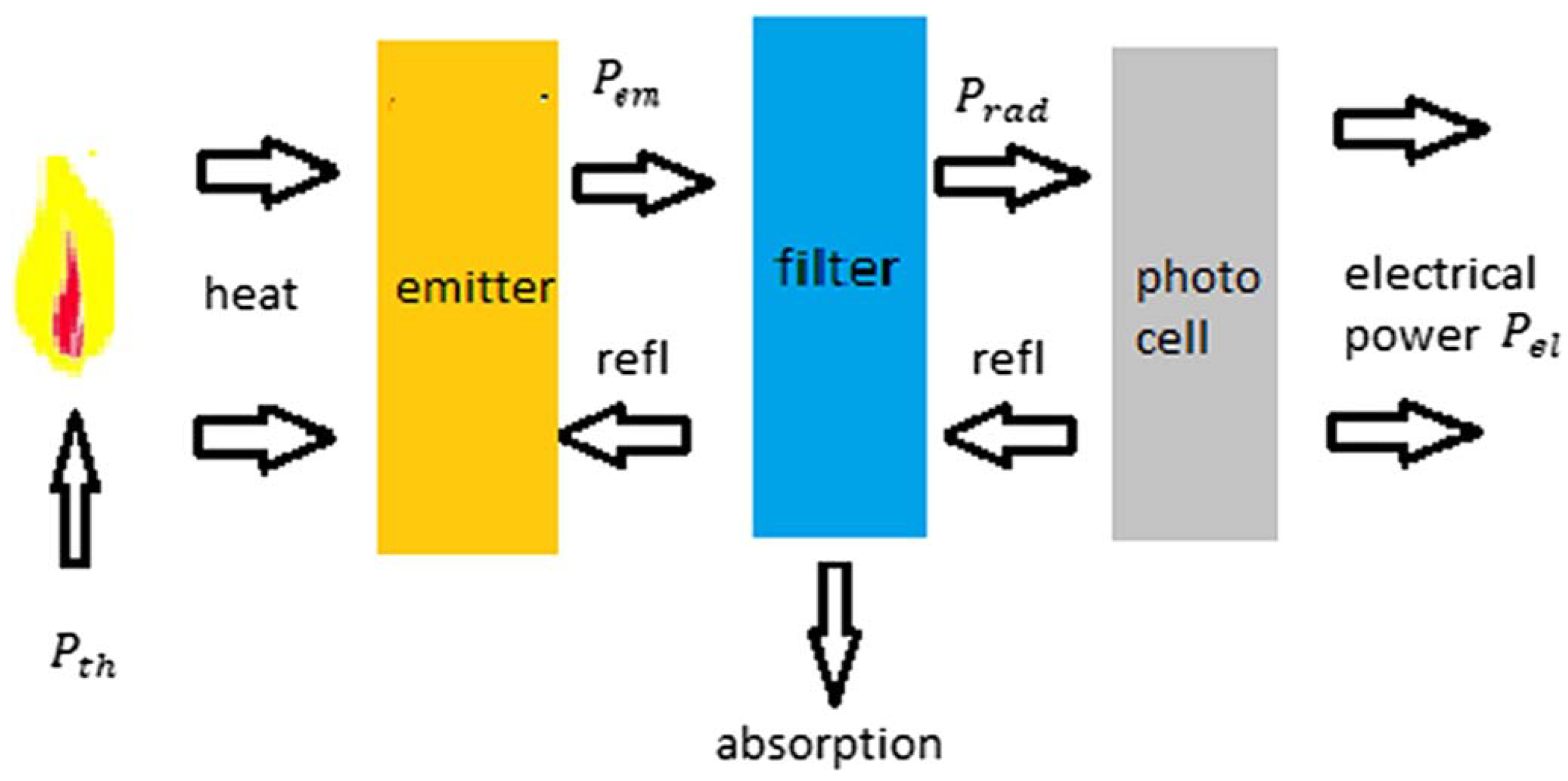
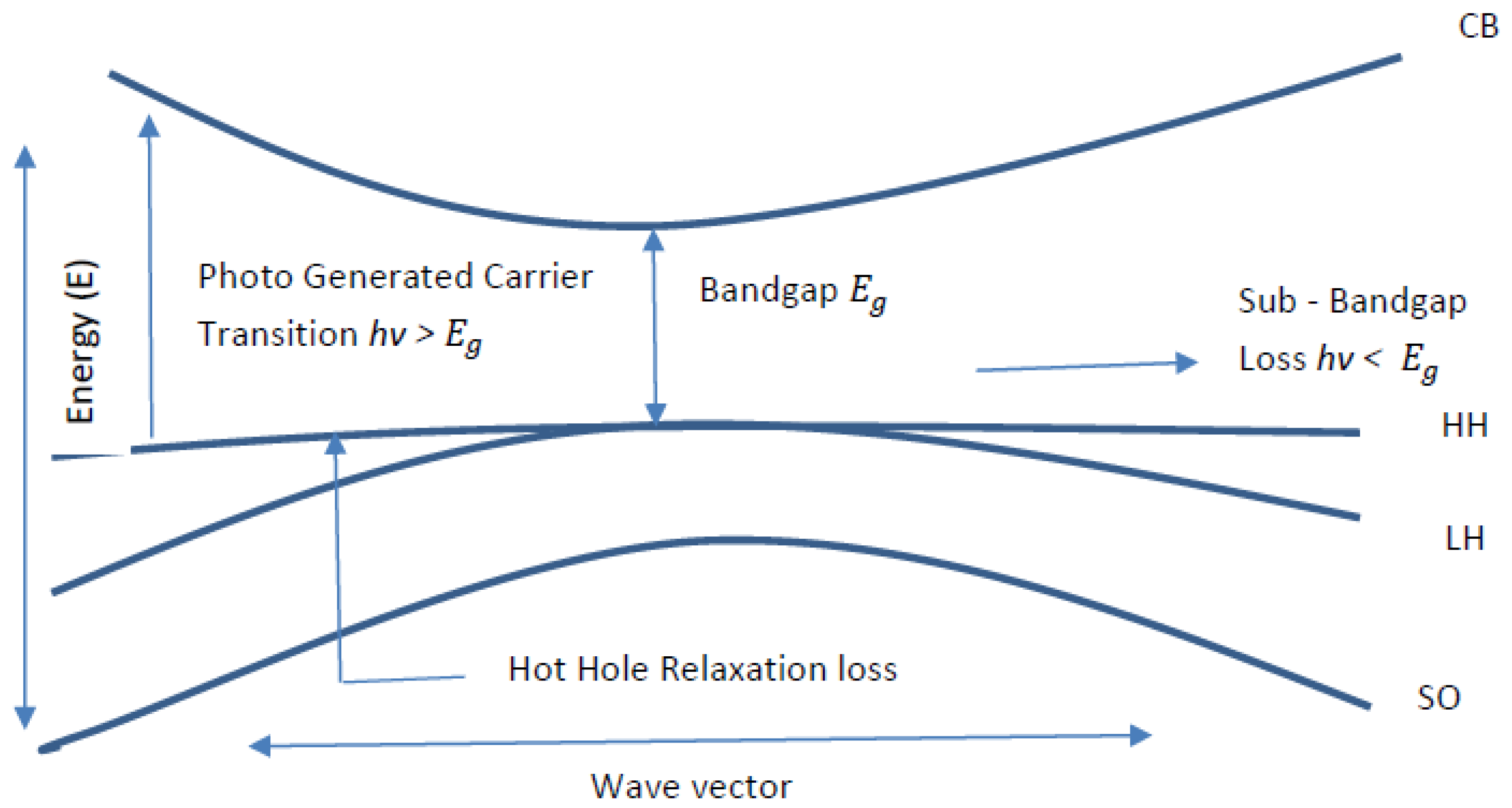
| Category | Characteristics of Technique | Efficiency (Module or Systems in Some Cases) |
|---|---|---|
| Common axis | SBS is formed by a reflective hologram and a quadratic surface | N/A |
| A broadband receiver combined with an opening in the center which includes another spectrally selective receiver, all together mounted in a above hologram | 21.4% (PV/T system) | |
| Multiple optical axis | A nonuniform diffractive-grating as a SBS | 34.7% (Dual-cell (InGaP/GaAs) system) In: Indium, Ga: Gallium, As: Arsenide |
| Micro-prism arrays as a SBS | 46.05% (Triple-cell (InGaP/GaAs/InGaAs) system) P: Phosphorus | |
| Zig-zag axis | Integrated diffractive/refractive optical element as a SBS A waveguide with engraved microstructures beneath the SBS | ≤55% (Module) |
| Combined condenser, SBS and out-coupling adapter in lenses, diffractive grating and a light-guide, respectively | 34.8% (module) 29.5% (Dual-cell silicon/germanium (Si/Ge) system) |
Publisher’s Note: MDPI stays neutral with regard to jurisdictional claims in published maps and institutional affiliations. |
© 2021 by the authors. Licensee MDPI, Basel, Switzerland. This article is an open access article distributed under the terms and conditions of the Creative Commons Attribution (CC BY) license (https://creativecommons.org/licenses/by/4.0/).
Share and Cite
Kapsalis, V.; Kyriakopoulos, G.; Zamparas, M.; Tolis, A. Investigation of the Photon to Charge Conversion and Its Implication on Photovoltaic Cell Efficient Operation. Energies 2021, 14, 3022. https://doi.org/10.3390/en14113022
Kapsalis V, Kyriakopoulos G, Zamparas M, Tolis A. Investigation of the Photon to Charge Conversion and Its Implication on Photovoltaic Cell Efficient Operation. Energies. 2021; 14(11):3022. https://doi.org/10.3390/en14113022
Chicago/Turabian StyleKapsalis, Vasileios, Grigorios Kyriakopoulos, Miltiadis Zamparas, and Athanasios Tolis. 2021. "Investigation of the Photon to Charge Conversion and Its Implication on Photovoltaic Cell Efficient Operation" Energies 14, no. 11: 3022. https://doi.org/10.3390/en14113022
APA StyleKapsalis, V., Kyriakopoulos, G., Zamparas, M., & Tolis, A. (2021). Investigation of the Photon to Charge Conversion and Its Implication on Photovoltaic Cell Efficient Operation. Energies, 14(11), 3022. https://doi.org/10.3390/en14113022









